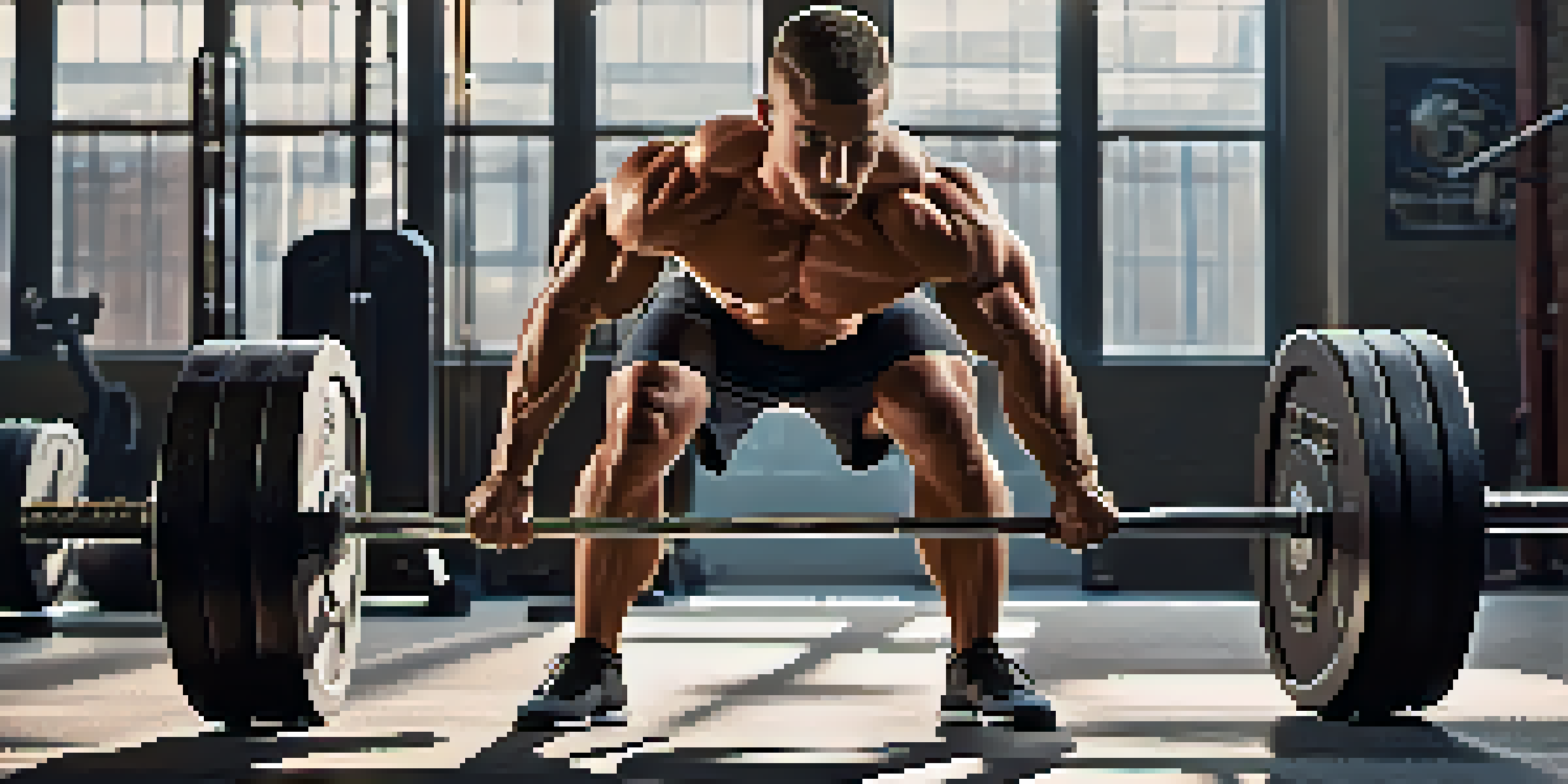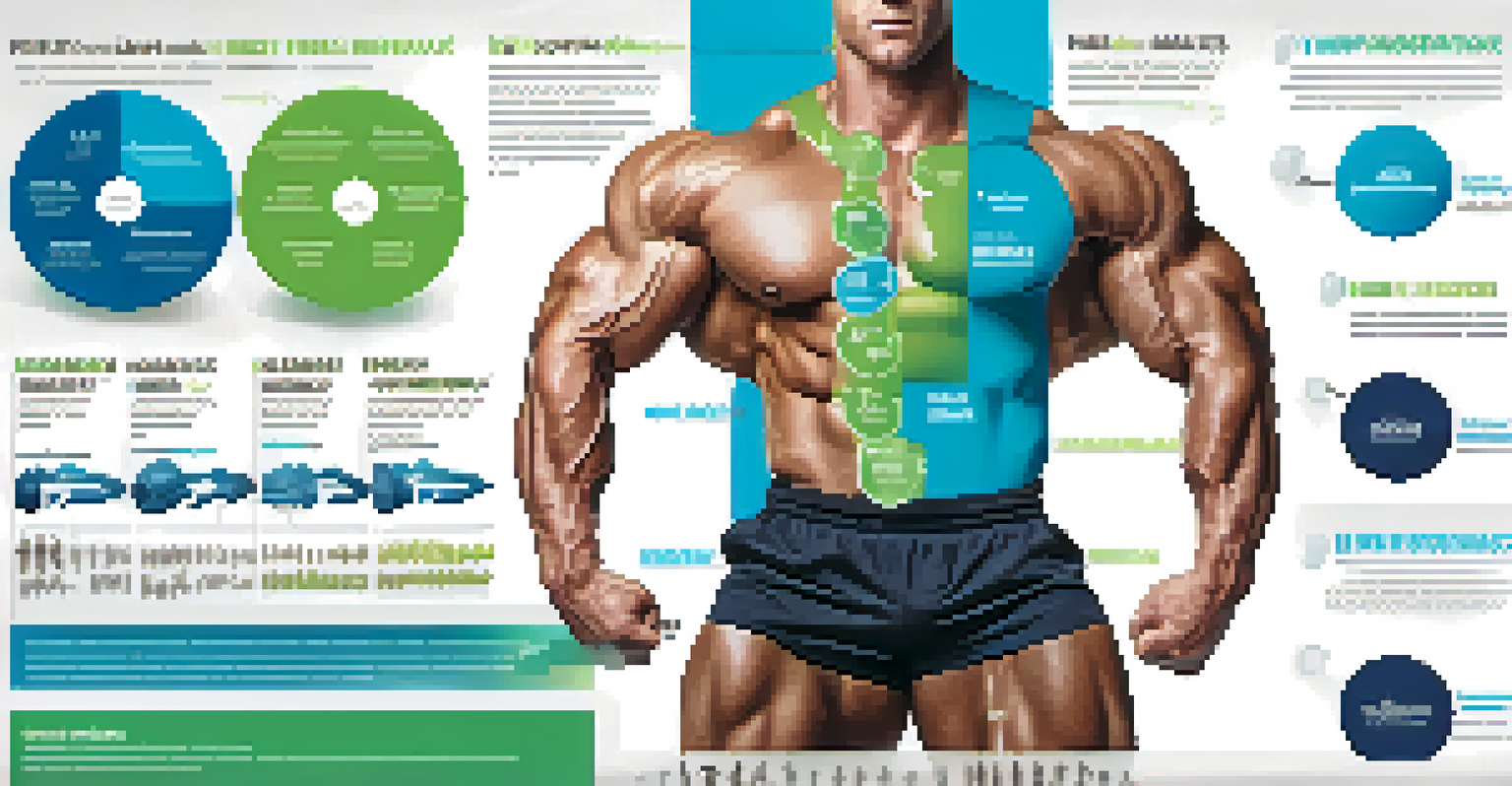Understanding Muscle Imbalances in Bodybuilding Injuries

What Are Muscle Imbalances and Why Do They Occur?
Muscle imbalances occur when one muscle group is stronger or more developed than its opposing group. This can lead to a variety of issues, especially in bodybuilding, where symmetry and strength balance are crucial. For instance, overdeveloped chest muscles compared to the back can pull the shoulders forward, affecting posture and performance.
Balance is not something you find, it's something you create.
Several factors contribute to muscle imbalances, including poor training techniques, inadequate recovery, and even daily habits like sitting for long periods. These discrepancies can sneak up on even the most dedicated athletes, often leading to compensatory movements that put stress on other muscles and joints. Essentially, it’s like driving a car with misaligned wheels; it might work for a while but will cause bigger problems down the road.
Recognizing and addressing muscle imbalances is vital for any bodybuilder aiming for longevity in their training. By understanding the root causes, athletes can implement strategies to promote balanced development and reduce the risk of injuries.
Common Muscle Imbalances in Bodybuilding
Certain muscle imbalances are more prevalent among bodybuilders, often due to specific training patterns. For example, many lifters focus heavily on their chest and biceps while neglecting the back and triceps. This can lead to an imbalance where the front of the body is much stronger than the back, increasing the risk of shoulder injuries and poor posture.

Another common scenario is the imbalance between the quadriceps and hamstrings. Bodybuilders might prioritize quad development with exercises like squats and leg presses, inadvertently creating a weaker hamstring group. This disparity can lead to knee injuries and hinder overall leg strength, affecting performance in all lower-body movements.
Muscle Imbalances Impact Performance
Unaddressed muscle imbalances can lead to poor posture, increased injury risk, and decreased overall performance in bodybuilding.
Understanding these common imbalances helps bodybuilders tailor their training programs more effectively. By identifying which muscle groups are lagging, athletes can focus on targeted exercises that promote balanced strength and reduce injury risk.
How Muscle Imbalances Lead to Injuries
Muscle imbalances can create instability in joints and improper movement patterns, leading to injuries over time. For instance, if your chest muscles are significantly stronger than your back muscles, this can cause the shoulders to round forward, putting undue stress on the shoulder joint. Over time, this imbalance may result in rotator cuff injuries or chronic shoulder pain.
Strength does not come from physical capacity. It comes from an indomitable will.
Additionally, imbalances can affect how the body absorbs shock during activities like running or heavy lifting. A weak muscle or group may fail to stabilize the joint effectively, leading to injuries such as strains or sprains. It’s similar to a shaky table with one leg shorter than the others; the uneven support can cause the table to tip over, just like how imbalances can lead to a breakdown in physical integrity.
Recognizing the signs of muscle imbalances early on can help prevent serious injuries. If you notice persistent pain or discomfort during specific movements, it might be time to reassess your training regimen and seek targeted exercises to strengthen weaker areas.
Assessing Muscle Imbalances: Key Techniques
To effectively address muscle imbalances, it’s essential to conduct a thorough assessment. This can involve simple self-checks, such as observing your body’s alignment in the mirror while performing exercises. Notice if one side of your body is consistently stronger or more developed than the other; this visual cue can be a clear indicator of imbalance.
Another effective method is to enlist the help of a qualified trainer or physical therapist who can perform functional movement screenings. These assessments can highlight weaknesses and tightness in certain muscle groups, allowing for a tailored approach to training. Think of it as having a GPS for your fitness journey; it helps you navigate your way to balanced development.
Corrective Exercises Are Essential
Incorporating targeted exercises and unilateral movements into your routine can help strengthen weaker muscle groups and promote balance.
Regularly reassessing your muscle balance is crucial, especially as your training progresses. By checking in on your body’s development, you can adjust your workout routine to ensure that all muscle groups are being adequately addressed, keeping injuries at bay.
Exercises to Correct Muscle Imbalances
Incorporating specific exercises into your routine can help correct muscle imbalances effectively. For example, if you notice a weakness in your back muscles, exercises like bent-over rows or face pulls can help strengthen those areas. These movements not only build muscle but also improve posture and enhance overall performance in other lifts.
Additionally, unilateral exercises, which target one side of the body at a time, can be particularly effective in addressing imbalances. Think of exercises like single-arm dumbbell presses or single-leg squats; they force each side to work independently, helping to identify and strengthen weaker muscle groups. It’s akin to tuning a musical instrument; you want to ensure each string is perfectly in tune for the best overall sound.
To make the most of your corrective exercises, it’s essential to maintain good form and focus on slow, controlled movements. This approach ensures that you’re engaging the right muscles and not compensating with stronger groups, allowing for balanced development over time.
The Role of Flexibility and Mobility in Balancing Muscles
Flexibility and mobility play a crucial role in preventing muscle imbalances and subsequent injuries. Tight muscles can inhibit proper movement patterns, leading to compensations that create imbalances over time. For instance, if your hip flexors are tight, they may limit your ability to perform squats correctly, leading to poor form and potential injury.
Incorporating regular stretching and mobility work into your routine can help alleviate tightness and promote balanced muscle function. Techniques such as static stretching, foam rolling, and dynamic warm-ups can improve your range of motion and enhance overall performance. Think of your body like a rubber band; without proper stretching, it might snap or lose its elasticity.
Flexibility Aids Injury Prevention
Regular flexibility and mobility work is crucial for maintaining proper movement patterns and preventing muscle imbalances.
Prioritizing flexibility and mobility not only supports muscle balance but also aids recovery after intense workouts. By ensuring your muscles are not only strong but also flexible, you pave the way for a more resilient and injury-free training experience.
Conclusion: Embracing Balance for Injury Prevention
In conclusion, understanding and addressing muscle imbalances is vital for anyone serious about bodybuilding. By recognizing the signs of imbalance, assessing your body, and incorporating corrective exercises, you can significantly reduce the risk of injury. Remember, achieving balance is not just about lifting heavier weights; it’s about smart training that promotes longevity in your fitness journey.
Incorporating flexibility and mobility work into your routine further supports balanced muscle development, ensuring that your body can perform optimally. Just as a well-tuned machine operates smoothly, a balanced body can handle the demands of rigorous training without breaking down.

Ultimately, embracing balance in your bodybuilding journey will not only enhance your performance but also create a healthier, injury-free lifestyle. So, take the time to evaluate your training habits, listen to your body, and prioritize balance for lasting success.